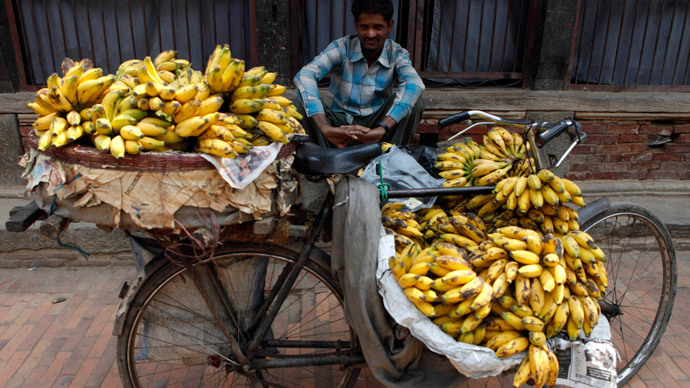World’s most popular banana faces eradication by deadly fungus

International concern is growing over the spread of Fusarium wilt, known as Panama disease, as there are fears it could destroy entire countries’ plantations of the Cavendish banana – the most popular and exported variety of the fruit in the world.
READ MORE: Scientists blame climate change for world’s biggest trees dying
The destructive fungus, Fusarium oxysporum f.sp. cubense Tropical
Race 4, or TR4, had been restricted to five Asian Cavendish
producing countries as well as Australia, but has now spread to
the Middle East and Mozambique.
The fungus blocks water carrying vessels in the plant and
produces deadly toxins so that the plant wilts and dies.
It also contaminates the soil around the banana plants for
several decades meaning that no Cavendish bananas can be grown
there until the land is fungus free. While other crops can be
grown and some native banana types are immune to the strain, it
remains a serious concern to commercial growers where the
Cavendish is grown for Western and domestic markets.
“Bananas are the world’s most consumed and exported fruit.
With 85 percent of all bananas being produced for domestic
consumption, you can imagine the impact of this disease of food
security and livelihoods in developing countries,” said
Fazil Dusunceli, a disease expert with the UN’s Food and
Agriculture Organization’s Plant Protection Division, reported
the Telegraph.
Moreover, the Cavendish subgroup composes the absolute majority
of bananas that are traded internationally.
READ MORE: Turning plastic into food? Incubator with hungry fungi can do just that
In April 2012, an African consortium of international researches
and growers met and accumulated their findings in the so-called
Stellenbosch Declaration, which aims to curtail the disease as
well as raise awareness.
The UN’s Food and Agricultural Organization (FAO) along with 30
other organizations has estimated that it will cost $47 million
to implement a plan to contain the disease.
Altus Viljoen, a plant pathologist at Stellenbosch University in
South Africa, says the task ahead is massive: “There are no
regulations in place at the moment, no common phytosanitary
practices and quarantine systems. We have to build all of this
together,” he said, as quoted by the Guardian.
The Cavendish banana is popular with growers because of its long
“green life” meaning it can be transported by ship.
However, cultivated plants, grown by means of vegetative
reproduction, do not develop resistance to diseases.
In the early 20th century, Panama disease attacked the
then-dominant Gros Michel banana variety, which eventually led to
the rise of the Cavendish. But it was later proved that the new
market favorite was not immune to the disease as well.
READ MORE: Earth closer to 'irreversible changes' as humanity crosses 4 of 9 planetary boundaries












